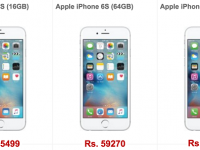It’s odd that we are talking of ‘value’ and ‘premium’ in the same breath. But honestly, the premium segment doesn’t mean just a big brand or ‘expensive’ title. Often when discussing the smartphones market, we end up talking about prices and value. Many such conversations later, I think there is a desperate need to share my experience as a retailer selling smartphones before I moved fulltime into writing. The value in the premium segment can be gauged and its not very difficult if you look at it logically.
Before I even begin, let us get a specific segment of the market out of the way. The ones who constitute < 1% of the market and splurge money on anything ranging from gadgets to cars without blinking.
The less than < 1%
Well before our favorite fruit company started making phones, I was selling Nokia communicators, O2 XDAs and even Palm Treos. Given my speciality in off beat and high-end devices, I moved in a different circle of secondhand traders in Mumbai. I was hunted for, the moment an alien looking smartphone like Motorola A1000 landed. It was always fascinating to see how ANY given model was available in the used market within A DAY of its launch. As good as new, they looked unused, but were selling for a discount. Over the years, I have learnt the same about the automobile industry as well (not a day there, but a week).
There is a small segment of people who like to try out the latest and they pick up anything that looks good / expensive / premium / is latest, without a worry for the price tag. The same is instantly discarded if it doesn’t fit the bill or once the lure settles. This holds true, irrespective of the brand, cost or utility. This is the < 1% of the market, who don’t look at value and by no means represent majority of consumers out there.
Lesson: Saying that anyone buys a particular phone or a accessory, just because it is expensive is a stupid assumption. For any journalist or man with authority saying this, it is an insulting remark to the consumers and a terrible mistake.
Is Your Product A Maruti Or a Skoda?
I understand little about cars, but having seen a lot of instances where a particular phone is compared to a car or a engine, I think I would quickly give a perspective on this.
When we relate a smartphone to a car, it is easy to jump and claim that xyz brand is like a BMW and buying xyv would mean taking a Ferrari with a Maruti engine. For all practical purposes a) mostly we are talking about Marutis, Hyundais and Skodas, not a BMW or Ferrari b) we should be talking about a hatchback or sedan, diesel / petrol / LPG or CNG, average, maintenance, music system and so on. Not just the brand. When we talk a smartphone don’t we consider so MANY factors? If we start comparing smartphones to cars, it would be a catchy title, but shortsighted.
And if some logical person dives into comparing the usage of the phone with analogies of a car, we would hear things like, ‘The Motorola A760 is a good low cost smartphone, but despite the sturdy built it’s maintenance is as bad as my 5 yr old Ford Ikon, the battery though is like my Maruti 800 and the built is comparable to Hyundai’s i20. However once it breaks, it is as bad as the Tata Indica.”
Lesson: Lets leave cars for the roads.
What Purpose Does The Product Solve?
The first rule for an entrepreneur is to find a need and fill that gap. I would hold the smartphones accountable in a similar manner. Different companies have different ways of justifying product viability, price tag and also claiming success. One may claim processor speed while another might show you screen size. Some may talk about megapixels or version of operating system while others may just hope that a cute design sells. How do we measure what really makes an impact?
There is no easy answer to it. I am giving a perspective from a point of view that smartphones are capable of doing smart things, getting it done is the users prerogative. One definitive way of measuring success of a smartphone is measuring its usage.
While a Wildfire S would sell in good numbers or a Micromax A60 or LG Optimus ME would sell with a smartphone OS, are the buyers of that segment using these phones as a smartphone? Certainly many are, but how much is that? I believe that out of a billion mobile phone users, ‘x’ million are smartphone users. But the phones being manufactured and sold for this segment are ‘x+’ millions. Clearly, many who are buying these smartphones aren’t using these devices as a smartphone.
This is where raw numbers can blind us. To quote a quick example, how many users of a given operating system browse the Internet? and how much? Or how much ARPU (average revenue per user) is an app developer able to make from the user of a given OS. These are metrics which prove how much is the usage of a product.
Lesson: Analytics is not as easy as counting numbers or looking at the price tag. Measuring how successful a phone as a smartphone is, is a matter of understanding how users are using the same and not necessarily how many are using it.
Pricing. The Good And Bad
By far the price is the most discussed factor when it comes to smartphones. Far too many times a product is said to be a flop, just because it wasn’t priced correctly. On the other hand, many phones are a hit because they are priced rightly. And then there is an entire debate on manufacturers dropping price of a product shortly after launch, which I have criticized on multiple occasions. So how does this price dynamics work and what gives MORE value to the consumers? Yes the perspective here is, what servers the consumers better?
Manufacturers drop prices for a variety of reasons, often the reason is that they feel the volumes would be significantly more if the pricing is reduced. This holds true for the Motorola Xoom, HTC Salsa and Samsung Galaxy Tab 7″ that launched in India at exorbitant prices and shortly after launch the prices were reduced significantly. For each of these three, the price was reduced as the demand at the launch price was poor. Another popular reason for reducing the price is competition. A Samsung Galaxy SII faces competition from LG Optimus 2X or the HTC Sensation. We can expect these three to fight each other on pricing to an extent.
I might be wrong if I blame any of the companies for doing this. It is a part of their business, by design. They compete with each other on specs, features and pricing. Would they be any less successful if the don’t do this? Probably yes, probably no. We won’t touch upon that.
Lets simply ask what about the consumer?
Anyone who bought the Samsung Galaxy Tab 7″ for over Rs 37000 is today getting roughly 40% value in the resale market (Rs 15,000). Is that good value for money? How did this happen? Well, Samsung reduced the pricing of the Galaxy Tab at regular intervals and today has another 10″ offering at less than Rs 37,000.
Another example. Look at the competing smartphones when the iPhone 3GS launched in 2009. Pick any of them, say the HTC Hero. Just for records, it launched for over Rs 30,000. Today it would fetch you Rs 6000 – 7000 depending on how good of a salesman you are. The iPhone 3GS on the other hand still gets you over Rs 12,000. Now why does this happen?
Reasons are plenty. HTC has discontinued the Hero nor can you expect official updates for it and on the flip side 3GS still sells (even though now discounted) and is getting software updates from Apple. It naturally raises the value. As a consumer had I invested in a 3GS, my returns are better.
Now before you start raising any more questions, let me the first to point out, things aren’t as simple as they appear. There might be a good reason for players like HTC or Samsung needing to do discontinue products and reduce prices (we discussed a couple of scenarios above). Here I would refrain from simply blaming them for their approach. But as a consumer, is the dropping price good for me? By now you should realize: Not Always, mostly not.
Is maintaining the price point the only way of delivering value? No. If you are a shopper in India, you know that Nokia is a brand that would give you the maximum returns. Not because they stick to a price point forever (though I must admit, I haven’t seen them slashing rates like crazy), its because people know that there is demand for this brand. There are some Nokia products that have bombed in the resale market and they deserved to, but largely the trust people put on brand Nokia favors the valuation. This brand hasn’t been built with TV commercials or SRK unveiling products, it has been built by a constant flow of good products, reliable hardware and widespread service. Something as simple as the fact that anywhere I travel, it is easy to get a Nokia charger to help me on a bad day, worked for Nokia.
This is one of those things where you can take either sides and debate for long. Both camps (the ones for a price drop soon after launch hype is over and the ones against it) would have arguments to deliver. While we may choose either side on a case to case basis, why is it not appreciated when a company sticks to a price point and delivers value?





